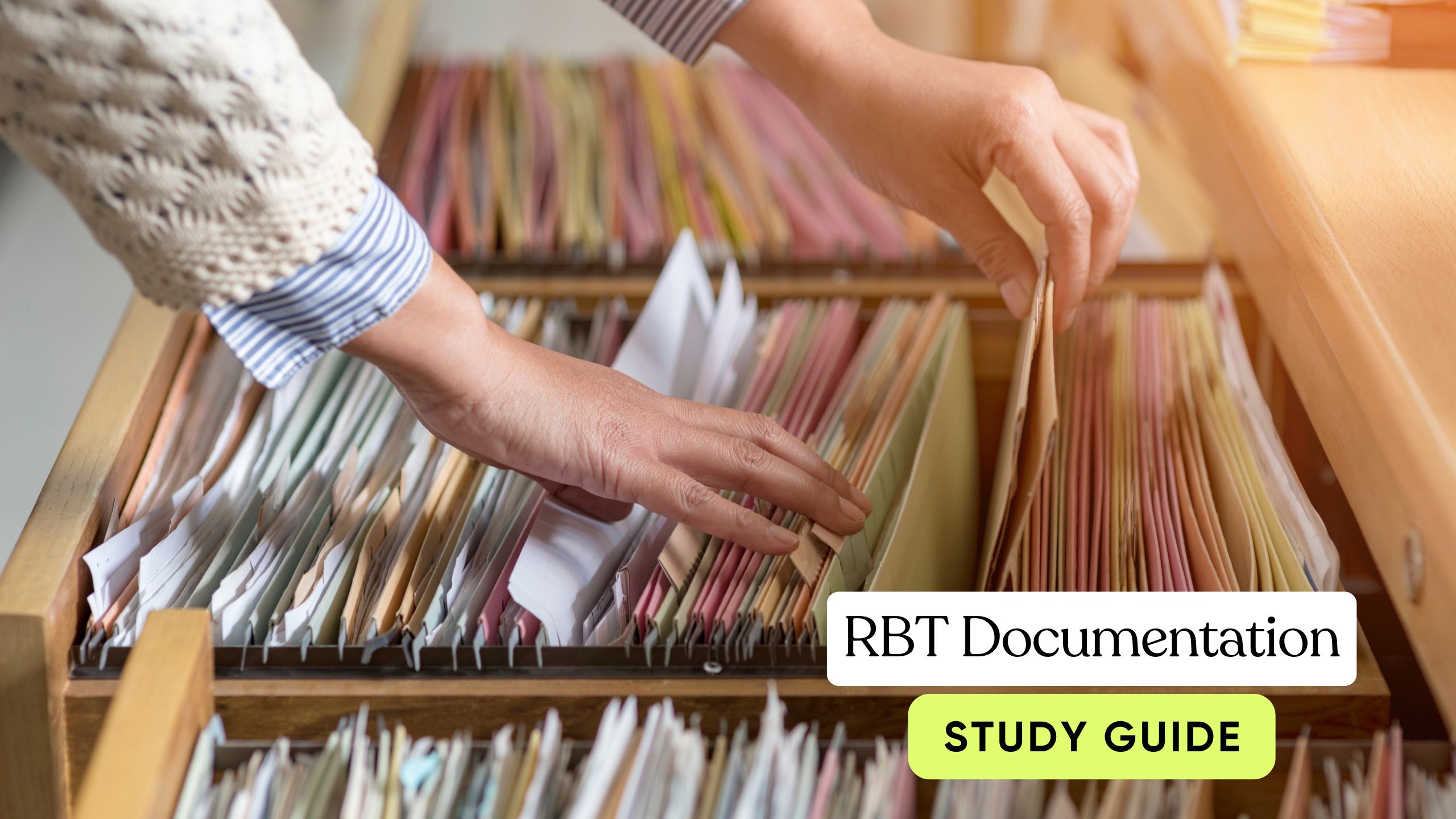Documentation and Reporting is the 5th Module in RBT Task List and it covers approximately 8 to 10 Questions in the RBT final exam. If you are planning to attend RBT final exam in 2025, you should have a good understanding about the Documentation and Reporting. RBT Documentation Study Guide helps to ensure clarity, accountability, and continuity. Clear documentation ensures that information is accurate, understandable, and can be easily shared. Reports on the other hand provides a record of decisions, actions, and results.
RBT Behavior Reduction Study Guide (D1 to D6)
RBT Documentation Study Guide (E1 to E5)
As per the 2nd Edition of RBT Task List, there are five Sections within the Documentation and Reporting module.
- Effectively communicate with a supervisor in an ongoing manner
- Actively seek clinical direction from supervisor in a timely manner
- Report other variables that might affect the client in a timely manner
- Generate objective session notes for service verification by describing what occurred during the sessions, in accordance with applicable legal, regulatory, and workplace requirements
- Comply with applicable legal, regulatory, and workplace data collection, storage, transportation, and documentation requirements.
#1 Effectively communicate with a supervisor in an ongoing manner (E1)
As RBTs required to communicate with higher officials like supervisors in day to day life, communicating effectively is necessary for any RBT. So that It will make things being clear, consistent, and professional. Regular updates about client progress, challenges, or changes in behavior help ensure the supervisor stays informed and can provide timely guidance. It’s important to ask questions when unsure, follow through on feedback, and report concerns or incidents immediately. Using professional language, keeping communication focused, and being open to constructive feedback also supports a strong working relationship. Scheduled check-ins, written reports, and quick verbal updates all contribute to maintaining effective and continuous communication with a supervisor.
#2 Actively seek clinical direction from supervisor in a timely manner (E2)
Actively seeking clinical direction from a supervisor in a timely manner is essential for effective service delivery. In this process RBTs may require proper guidance in unexpected behaviors, unclear protocols, or ethical concerns and reaching out promptly for support. This ensures that interventions remain consistent with the behavior plan and best practices. Communicating early helps prevent potential issues and shows accountability and professionalism. Using clear, concise communication whether through emails, written notes, or scheduled meetings also helps the supervisor provide appropriate and timely feedback to support client progress.
#3 Report other variables that might affect the client in a timely manner (E3)
Reporting variables that might affect the client in a timely manner is crucial for accurate data collection and effective treatment planning. These variables can include changes in medication, illness, sleep patterns, family dynamics, school routines, or environmental factors like moving homes or schedule disruptions. When such changes are observed or reported, it’s important to inform the supervisor or clinical team as soon as possible. Prompt reporting ensures that the treatment plan can be adjusted if needed and helps avoid misinterpreting behavioral changes. Timely communication supports better decision making and promotes the client’s overall well-being.
#4 Generate objective session notes for service verification by describing what occurred during the sessions, in accordance with applicable legal, regulatory, and workplace requirements (E4)
RBTS always be prepated. So, they maintain a special session notes for each client. The sample notes is as follows.
Client Name: [Client’s initials or ID]
Date: [MM/DD/YYYY]
Time: 2:00 PM – 4:00 PM
Service Provided: ABA Therapy
Provider: [Your Name / RBT]
Supervisor: [BCBA’s Name]
Session Summary:
The session took place in the home setting and followed the client’s individualized treatment plan. Instructional programs targeted communication, behavior reduction, and daily living skills. The client was responsive and in a calm mood for the majority of the session.
Target Behaviors:
The client engaged in task refusal twice during academic demands. Escape extinction and differential reinforcement were implemented per protocol. No aggression or property destruction occurred.
Skills Programs:
- Manding: The client independently requested preferred items using full sentences 8 out of 10 opportunities.
- Receptive Instructions: The client followed 5/6 one-step directions with minimal prompts.
- Daily Living: Practiced toothbrushing with visual supports; required one verbal prompt to complete the sequence.
Reinforcement:
Tangible and verbal praise were provided following correct responses and on-task behavior.
Prompt Levels Used:
Gestural, verbal, and physical prompts were faded as appropriate per program goals.
Additional Notes:
Client’s sibling entered the room during one activity, briefly disrupting focus. The environment was redirected and the session resumed without issue.
Parent/Caregiver Involvement:
Parent was present for part of the session and observed skill-building activities. Strategies were modeled for reinforcement at home.
No injuries or incidents occurred.
Signature: _____________________
Provider Name: [Your Full Name]
Credentials: RBT
Date Completed: [MM/DD/YYYY]
#5 Comply with applicable legal, regulatory, and workplace data collection, storage, transportation, and documentation requirements (E5)
Complying with legal, regulatory, and workplace requirements for data collection, storage, transportation, and documentation is essential to protect client confidentiality and ensure the integrity of services. All data must be collected accurately, objectively, and in alignment with the client’s treatment plan. Documentation should be completed promptly, using approved formats, and stored securely either in locked physical storage or password-protected digital systems in accordance with HIPAA and organizational policies. When transporting data, it must be kept confidential, such as using sealed folders or encrypted files. Only authorized personnel should access client information, and any breaches must be reported immediately following proper protocol. Following these guidelines helps maintain ethical standards, legal compliance, and client trust.
